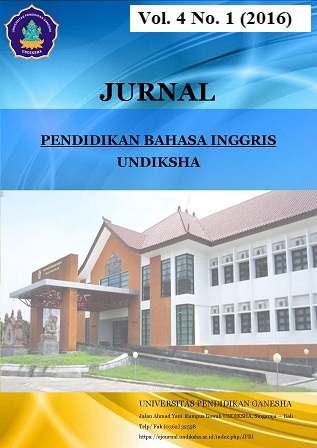AN ANALYSIS OF DERIVATIONAL AND INFLECTIONAL PROCESSES IN THE SIDATAPA DIALECT OF BALINESE: A DESCRIPTIVE STUDY
DOI:
https://doi.org/10.23887/jpbi.v4i1.8111Abstract
Penelitian ini bertujuan untuk mendeskripsikan awalan dan akhiran di Dialek Bahasa Bali Sidetapa yang mengalami derivasi dan infleksi. Penelitian ini merupakan penelitian deskriptif kualitatif. Terdapat tiga informan utama dan tiga informan sekunder dalam penelitian ini. Data dikumpulkan berdasarkan empat teknik: teknik observasi, elisitasi, rekaman dan pencatatan. Instrumen yang digunakan dalam mengumpulkan data: daftar kata, alat perekam digital, kamera dan daftar pertanyaan. Ada tiga proses dalam menganalisa data: reduksi data, penggambaran data dan penarikan kesimpulan. Hasil dari penelitian menunjukan bahwa ada tiga jenis awalan: {me-}, {N-}, dan {pe-}, dan dua jenis akhiran: {-ng} dan {-e}, yang mengalami proses derivasi pada Dialek Bahasa Bali Sidetapa. Terdapat tiga jenis awalan: {me-}, {N-} dan {a-} dan lima jenis akhiran: {-ng}, {-ne}, {-e}, {-in} dan {-an}, yang mengalami infleksi dalam Dialek Bahasa Bali Sidetapa. Terdapat beberapa fungsi grammar awalan dan akhiran seperti: imbuhan untuk membentuk kata kerja (imperatif), untuk membentuk kata nominal (artikel definitif), untuk membentuk kata bilangan, pembentuk kata kerja aktif, pembentuk kata kerja pasif, dan imbuhan untuk membentuk kata sifat (komparatif).Kata Kunci : proses derivasional, proses infleksional, Dialek Bahasa Bali Sidetapa
The study aimed at describing the kinds of prefixes and suffixes in Sidetapa dialect of Balinese that undergo derivation and inflection process. This research was a descriptive qualitative research. There were three main informants and three secondary informants in this research. The data were collected based on four techniques, namely: observation, elicitation, recording, and note taking technique. The data were collected by using some instruments: words list, digital recorder, camera, and questions list. There were three processes in analyzing the data: data reduction, data display, and conclusion drawing. The results of the study show that there are three kinds of prefix: {me-}, {pe-} and {N-}, and two kinds of suffix: {-e} and {-ng}, which undergo derivational process in Sidetapa dialect of Balinese. There are three kinds of prefix: {me-}, {N-} and {a-} , and five kinds of suffix: {-ng}, {-ne}, {-e}, {-in} dan {-an}, which undergo inflectional process in the dialect. There are several grammatical functions of prefixes and suffixes in the dialect such as: affix forming verbal (imperative), affix forming nominal (definite article), affix forming numeral, activizer, passivizer, and affix forming adjective (comparative).
keyword : derivational process, inflectional process, Sidetapa Dialect of Balinese
Published
2016-07-29
Issue
Section
Articles
License
Authors who publish with the Jurnal Pendidikan Bahasa Inggris Undiksha agree to the following terms:- Authors retain copyright and grant the journal the right of first publication with the work simultaneously licensed under a Creative Commons Attribution License (CC BY-SA 4.0) that allows others to share the work with an acknowledgment of the work's authorship and initial publication in this journal
- Authors are able to enter into separate, additional contractual arrangements for the non-exclusive distribution of the journal's published version of the work (e.g., post it to an institutional repository or publish it in a book), with an acknowledgment of its initial publication in this journal.
- Authors are permitted and encouraged to post their work online (e.g., in institutional repositories or on their website) prior to and during the submission process, as it can lead to productive exchanges, as well as earlier and greater citation of published work. (See The Effect of Open Access)













